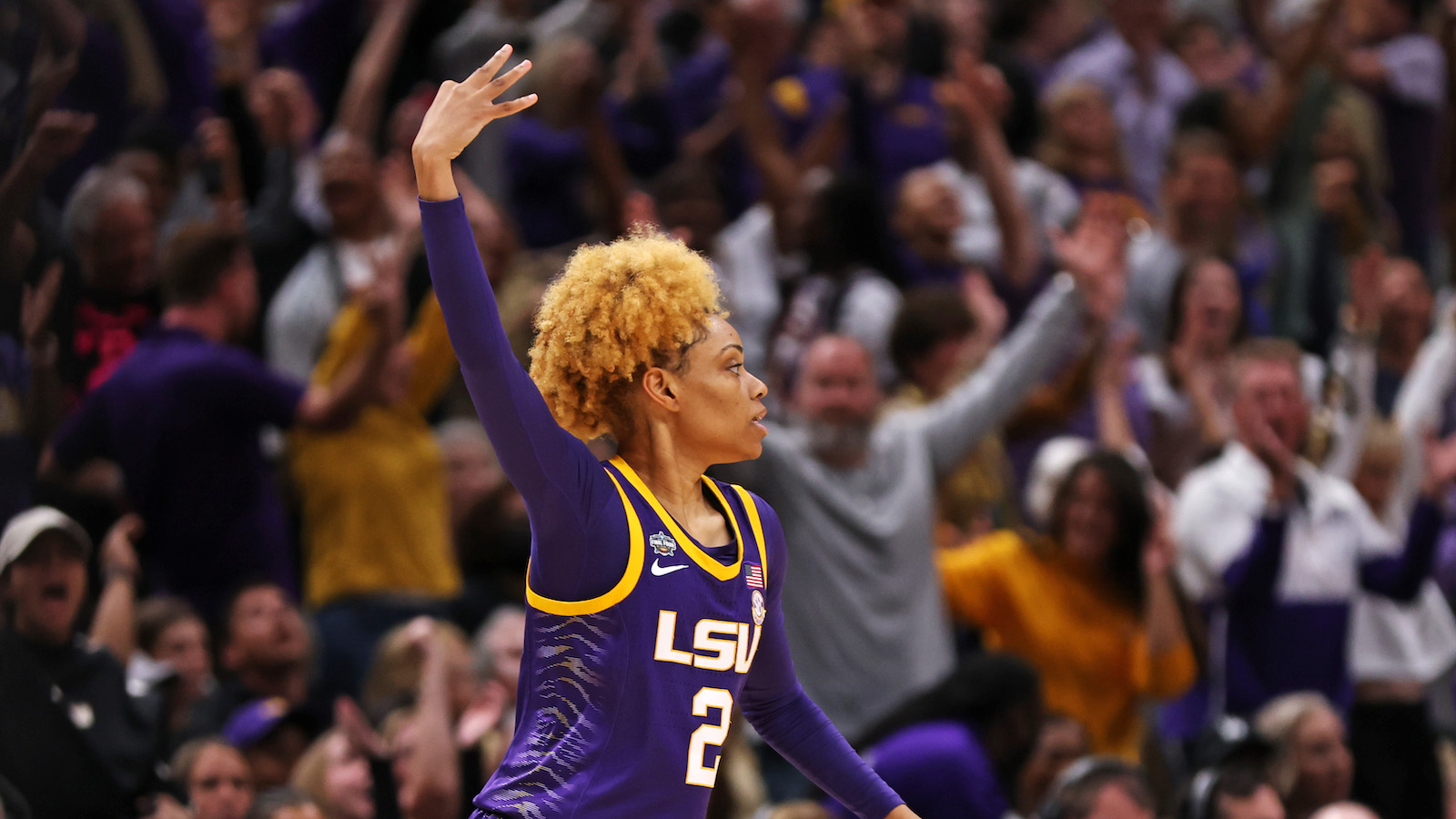What does a bench-scorer's perfect game look like? Ask a handful of shooters and you might get a handful of different answers—a perfect shooting percentage, a scoring burst in the fourth quarter, an efficient 35 points, a game-winning shot, etc. Perhaps the truest version of scorer's paradise looks like what Jasmine Carson experienced yesterday: play heavy first-half minutes in a championship game because everyone else got in foul trouble, score 21 points by shooting 7-of-7 from the floor, singlehandedly build your team a 17-point halftime lead, take the rest of the night off.
Carson, a graduate transfer who previously played at Georgia Tech and then West Virginia, was probably not very high on Iowa's pregame list of things to worry about. She had been a relatively solid bench piece for LSU throughout the season, scoring just under nine points per game and shooting 34 percent from three, but she'd been more or less invisible during the tournament. The 22 points she scored in 22 minutes in Sunday's championship game were the most she'd scored since a 25-point outburst against Florida back in February, and she had scored a total of 11 points in the previous five tournament games. She played a combined 23 minutes in LSU's Elite Eight and Final Four victories, taking three shots and scoring zero points across both games. If Iowa had to bet on one player not hurting them on Sunday, they might have picked Carson.
The thing about sports is that they have a wicked sense of irony, and Carson's first-half blitz will probably leave a few Iowa players and coaches wondering if they'd done something in a previous life worthy of punishment. The thing is, Iowa had just gotten past a juggernaut South Carolina team that abhorred outside shooting, feasted on the glass, and was powered by a dynamic big and a skittery point guard. All of those descriptors fit LSU, too. This is a team that was 334th in the country in percentage of points scored from three-pointers, (according to Her Hoop Stats), and took less than 20 percent of its shots from outside the arc. The plan that had worked so well against South Carolina—stay home on the bigs, pack the paint, rudely ignore anyone even thinking about taking a three—could also have been expected to work against LSU. Maybe it would have, had it not been for the parade of early whistles that forced LSU to rely on its bench for most of the first half. Carson was out on the floor first by necessity, but stayed there by force.
It's funny to watch how the Iowa defenders' attitudes towards Carson evolved over the course of the first half. Her first shot, a long three from the top of the key, elicited nothing more than a half-hearted closeout from Caitlin Clark, who must have felt the defense was working as intended if LSU was settling for shots like that. By the time Carson took her last shot of the half, a wild buzzer-beater that banked its way into the hoop, she had two defenders trying to chase her off the line. This is what it looks like when a plan, and a set of expectations, fall apart in real time.
If there's anyone in the world who wasn't surprised by Carson and LSU's shooting performance, they probably wear an LSU uniform. After the game, it became clear that LSU had not only taken particular notice of how Iowa had defended South Carolina, but had gone into the game eager to punish the Hawkeyes if they deployed a similar defensive scheme. Alexis Morris said as much in her postgame comments, and Angel Reese went so far as to say that her now famous taunt of Clark in the game's dying moments was a direct response to the way Clark had waved off a South Carolina shooter in the Final Four.
"I don't take disrespect lightly."
— SportsCenter (@SportsCenter) April 2, 2023
Angel Reese on her celebration in front of Caitlin Clark. pic.twitter.com/IxrdUz1ae6
"I don't take disrespect lightly," Reese said. "And she disrespected Alexis, and my girls, South Carolina they still my SEC girls, too, y'all not going to disrespect them either."
Carson wasn't quite as pointed when explaining what motivated her to fire away. "We watched film on how they were playing South Carolina, and I had an idea that they were probably going to try to sag off us in the beginning," she said. "So as a shooter, when somebody sags off you, that's the green light. That's what we capitalized off tonight."
Some players, like Reese, thrive based on their ability to sprout various slights out of arid conditions—You will not vicariously disrespect me by disrespecting someone who plays for a whole different team—and then carefully nurture those slights, like a bonsai tree of motivational spite. Players like Carson, though, tend to tap into something more basic. Catch. See the space. Green light. Shoot. Repeat. Do that enough times in 22 minutes, and you can end up a legend without even having to touch the ball in the second half.






